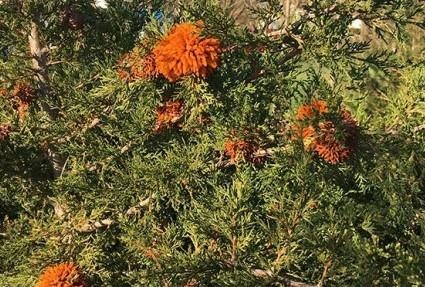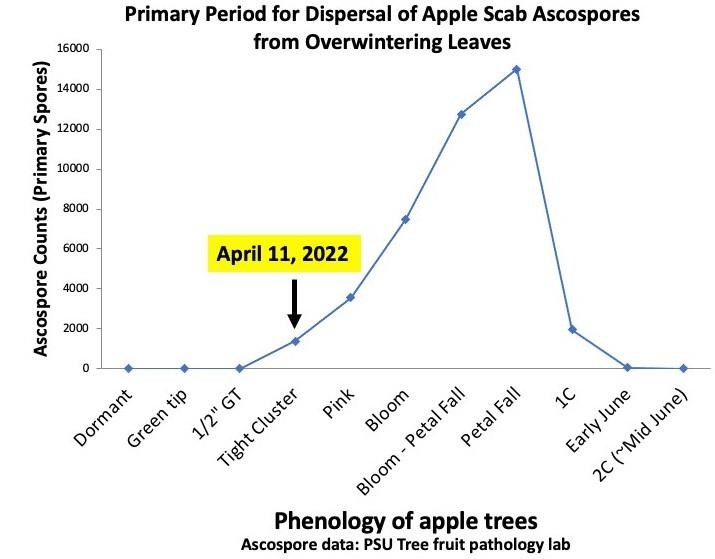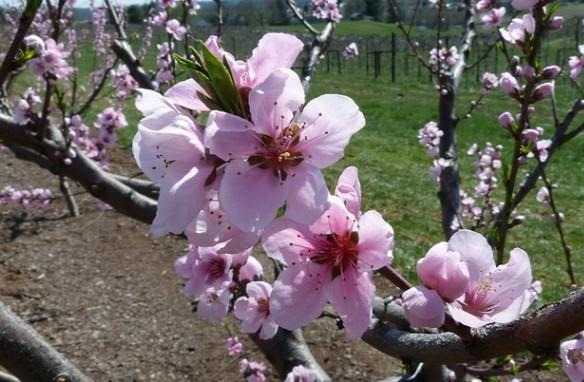By Kari A. Peter
The forecast is about 50/50 for a rain event this week, depending on your location. It is important growers remain alert from April 12–16 since there may be conducive infection conditions for apple scab and rust on apple trees and brown rot blossom blight on any blooming stone fruit trees.

Figure 1. Rust galls are active and protection will be needed on trees prior to rain events.
General Disease Management During the Early Season
As I have been advocating for a few years, the green tip through the first cover should include a rainfast mancozeb (Manzate Pro-Stick, Roper Rainshield, etc.). The rainfast quality of the mancozeb gives better disease control since it can persist longer during rainy, wet periods. Any non-rainfast mancozeb can be made rainfast by adding a spreader sticker (4 fl oz/100 gal). In some cases, mancozeb could be extended to second cover; however, be mindful of the 77-day PHI for early cultivars. A spreader sticker is not recommended for growers using captan during the early season since captan already has a “rainfast” quality. No additional spreader sticker is necessary if you are using a “captozeb” mix of captan plus mancozeb. However, considering supply issues with captan this season, growers may want to conserve their captan supply during the early season and save it for summer cover sprays. If you choose to use ziram (instead of mancozeb or captan), adding a spreader sticker will make it rainfast.

Disease Management During Tight Cluster
Diseases: apple scab, rust, powdery mildew
Tight cluster begins powdery mildew control. If conditions are dry, focus on managing powdery mildew by using products such as Rally, Topguard/Rhyme, Trionic/Procure, Torino, sulfur, or potassium bicarbonate. Torino can be used once per season on apple. In 2021, we experienced many dry days during the early season, and powdery mildew caught some people off guard. Although dry weather favors low apple scab disease pressure, this is not the case for powdery mildew. Please do not forget about powdery mildew during those dry days. Some strong powdery mildew products are not as effective against scab; however, tank mixing with a broad-spectrum fungicide (i.e., mancozeb) will keep the scab in check when we do have rain events in the middle of dry stretches. For those using low-risk programs, sulfur and potassium bicarbonate can control powdery mildew and scab.
If disease conditions are favorable for scab and rust (warm and wet), consider using fungicides from FRAC Groups 3 or 9:
- Cevya (FRAC Group 3; 5 fl oz/A)
- Indar (FRAC Group 3; 8 fl oz/A)
- Inspire Super (FRAC Groups 3 + 9; 12 fl oz/A)
- Scala (FRAC Group 9; 5 – 10 fl oz/A)
- Vangard. (FRAC Group 9; 5 oz/A)
Growers are highly encouraged not to use the FRAC Group 7 fungicides during this time; these fungicides are best saved for peak apple scab pressure, which is from pink through petal fall.
Disease Management During Pink
Diseases: apple scab, rust, powdery mildew
Scab spores will start to increase significantly during the late pink and will peak during bloom through petal all.
Continue to hold off using the FRAC Group 7 fungicides, saving those options for bloom through petal fall. Instead, focus on FRAC Group 3 and 9 fungicides during pink.
- Cevya (FRAC Group 3; 5 fl oz/A)
- Indar (FRAC Group 3; 8 fl oz/A)
- Inspire Super (FRAC Groups 3 + 9; 12 fl oz/A)
- Scala (FRAC Group 9; 5 – 10 fl oz/A)
- Vangard (FRAC Group 9; 5 oz/A)
Disease Management During Bloom on Stone Fruit
Blossom infections from the brown-rot fungus can occur whenever pistils are exposed and a favorable climate exists. Infections can occur during any wetting period when temperatures are between 41 and 86°F. However, optimum conditions for infection occur with wetting and temperatures in the mid-70s. Blossoms can be infected during long wetting periods (several days or more) regardless of temperature. Generally, infections that occur when conditions are sub-optimal are less severe. Blossoms and fruitlets will remain susceptible until the pistil desiccates (sometime between petal fall and shuck split).

Figure 2. Protect any blooming stone fruit trees from brown rot blossom blight.
Keep blossoms protected with fungicides for blossom blight. Products to use during this period would be Rovral, Meteor, and Iprodione. These fungicides are in FRAC Group 2 and can only be used through petal fall. Another option is Topsin M (thiophanate methyl), FRAC Group 1. Focusing on these options during bloom would allow the FRAC Groups 3, 9, 7, and 11 to be saved for preharvest brown rot management when keeping fungicide resistance management in mind. Be sure to tank mix fungicides with a broad-spectrum protectant for fungicide resistance management during the bloom period (captan, ziram, chlorothalonil).
Commercial fruit growers, please note:
When controlling for disease, weather and tree growth conditions need to be monitored at a local level within one's own orchard. To assist with management decisions (especially infection events), growers can use the NEWA website, which has weather stations all over Pennsylvania. Before chemical products are applied, be sure to comply by obtaining the current usage regulations and examining the product label. Product information can be easily obtained from CDMS.
Source : psu.edu